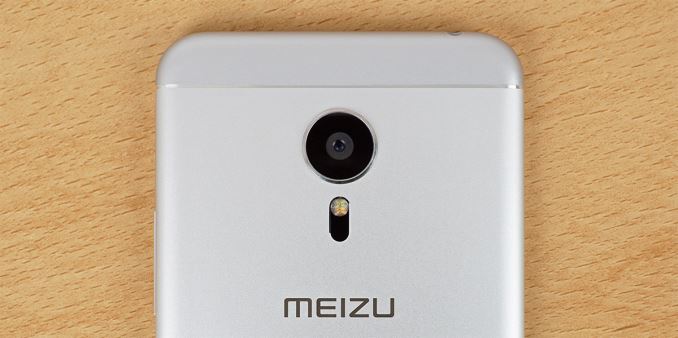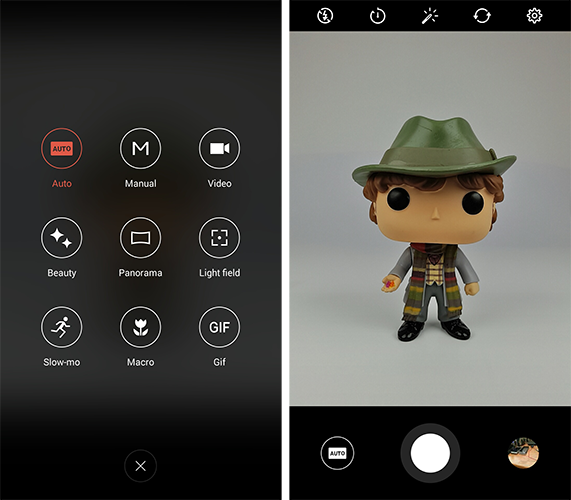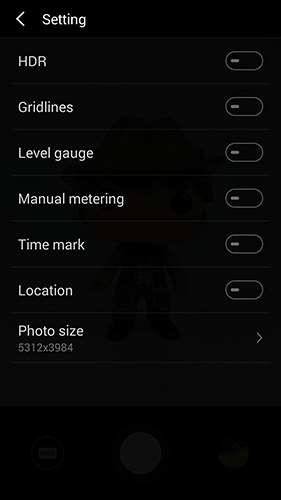The Meizu PRO 5 Review
by Matt Humrick on June 24, 2016 8:00 AM EST- Posted in
- Smartphones
- Exynos
- Mobile
- Meizu
- Exynos 7420
Camera Hardware
The PRO 5’s rear camera uses a Sony IMX230 Exmor RS sensor that captures up to 21MP images with a 4:3 aspect ratio. This is the same sensor used in Motorola’s Moto X Pure Edition, which takes nice pictures in good lighting but struggles a bit in lower-light scenes—partly because of software processing and partly from a lack of optical image stabilization (OIS). The PRO 5 also lacks OIS. We’ll see how this impacts its low-light performance in the next section.
The rear camera’s strength is its hybrid autofocus system that combines phase detect autofocus (PDAF)—using up to 192 AF points on the Sony sensor—laser autofocus, and traditional contrast-based AF as a fallback to provide fast, reliable focusing under a range of lighting conditions. This is still a rare feature; most phones, even the most expensive flagships from Apple and Samsung, only combine two AF methods, either PDAF/contrast or laser/contrast. But combining PDAF and laser makes sense: PDAF works well at longer distances and in good lighting, while laser works well at short distances and in poor lighting.
| Camera Architecture | |
| Meizu PRO 5 | |
| Front Camera: Resolution | 5MP |
| Front Camera: Sensor | OmniVision OV5670 (1.12µm, 1/5") |
| Front Camera: Focal Length | 2.64mm (27mm equivalent) |
| Front Camera: Aperture | f/2.0 |
| Rear Camera: Resolution | 21.16MP |
| Rear Camera: Sensor | Sony IMX230 Exmor RS (1.12µm, 1/2.4") |
| Rear Camera: Focal Length | 4.73mm (27mm equivalent) |
| Rear Camera: Aperture | f/2.2 |
Positioned in front of the rear camera sensor is a 6-element LARGAN lens system that helps improve sharpness near the edges of the image, according to Meizu. The 27mm focal length (35mm equivalent) is fairly typical for smartphone cameras today. Shorter focal lengths increase field of view at the expense of magnification (objects in the image will be comparatively smaller than what is seen by the naked eye for focal lengths less than about 50mm). Because most smartphone cameras lack optical zoom lenses, there’s no way to compensate for the this effect without either compromising image quality by using digital zoom or physically getting closer to the subject. This is why I personally do not like the current trend towards shorter focal lengths.
The lens’ aperture is important, because it determines how much light reaches the sensor. The PRO 5’s f/2.2 lens gives it an aperture area 10% larger than the Huawei P9 and 30% larger than the iPhone 6s Plus; however, its aperture area is 15% smaller than the Nexus 6P and Moto X Pure Edition and 26% smaller than the Galaxy S7, which currently has the largest aperture area of any smartphone. The lack of OIS and an aperture area that’s merely average could hold back the PRO 5’s low-light performance.
The 5MP front-facing camera uses an OmniVision OV5670 sensor, which we’ve also seen in the Asus ZenFone 2. This choice is a little disappointing, because of its small format; smaller sensors capture less light. Many competing phones use 5MP cameras with a 1/4" format and larger 1.4µm pixels.
Camera UX
Meizu’s camera app has a very basic user interface in the default Auto mode. Located along one edge are controls for the flash and timer, along with a toggle to apply various image filters. The HDR control is in the settings menu, which is accessed by tapping the gear icon. With Meizu’s camera app, HDR is either on or off—there’s no automatic HDR mode—so not having an HDR toggle in the main UI is inconvenient.
Tapping the button to the left of the shutter button opens the camera mode selection menu, shown on the left in the screenshot above. Most of the modes are self explanatory. The “Gif” mode, for example, records a six-second video and turns it into a 320x320 animated gif. The “Light field” mode’s label is a bit misleading. It’s actually a selective focus mode that rapidly takes between five to ten pictures at different focal distances. This allows you to change the object in focus later in post-processing. The feature works as intended, but image size is restricted to only 5MP, which significantly degrades quality. It’s also worth noting that the Panorama, Light field, Macro, and Slow-mo modes are not available when using the front-facing camera.
The settings menu is pretty simple, providing control over a few additional features as well as photo and video resolution. There’s an optional level gauge feature that turns the shutter button into a pseudo-bubble-level; however, the level is laggy and inaccurate, making it far less useful than just lining up your shot by using the grid lines. It’s nice to see an option for manual metering, though, which allows you to set focus and exposure points independently.
Meizu’s camera app also provides a manual mode, although it’s not on par with LG’s or Samsung’s. The first issue is that the UI is fixed to portrait mode and does not rotate into landscape mode. This also affects the settings and camera modes menus, which are also portrait only. Another issue, primarily affecting the saturation, contrast, and white balance controls, is that the adjustment slider only offers a few preset values rather than a continuous range of adjustment. This oversight makes these controls next to useless. Finally, there’s no live preview of changes to shutter speed and ISO, which turns image exposure into a guessing game. Because of these flaws, it’s best to just leave the PRO 5 in auto mode and ignore Meizu’s manual mode, correcting any subsequent shortcomings in software later.
No camera app would be complete without beauty and panorama modes. The beauty mode has controls to make your eyes larger, chin slimmer, and skin smooth and pale, but stops short of making you look like a space alien.















80 Comments
View All Comments
Matt Humrick - Friday, June 24, 2016 - link
A few reasons:1) AnandTech has a global audience and we're trying to be more inclusive.
2) The Chinese OEMs are becoming increasingly relevant. Huawei is the third largest smartphone company by volume, for example.
3) Not all of the Chinese phones are bad.
4) Coincidence. Between a bevy of new device announcements and new relationships with companies, we received a windfall of devices from Chinese OEMs this spring. Also, some of our reviews are behind schedule (you may have noticed :), which jumbles the publishing order.
Will you continue to see reviews of devices from China? Yes. But we're not going to forget our readers in the US.
LiverpoolFC5903 - Tuesday, July 5, 2016 - link
Meizu is one of the best Chinese odms out there, with impeccable build quality and nice little innovations like the multifunctional home button that recognizes a tap as well as is mechanically click able.Love the fact that AT is doing more reviews of Chinese phones. Quite a few of Europeans are starting to import directly from China.
The beloved iPhone is also fully manufactured in China as well so readers would do well not to raise non existent quality issues.
justaway2 - Friday, June 24, 2016 - link
What's the point of reviewing phones that doesn't support North American LTE bands properly? This is a North American review site, after all. Band 7 and 38 are sparingly used in some spots in Canada, and 41 is only used on Sprint in the US. The rest are useless in NA.LTE band 1(2100), 3(1800), 7(2600), 38(2600), 39(1900), 40(2300), 41(2500)
It really bothers me how essentially no reviews ever talk about LTE band support.
BrokenCrayons - Friday, June 24, 2016 - link
This might be a surprise, but there are a lot of people on the planet that don't live in North America.justaway2 - Friday, June 24, 2016 - link
Is Anandtech not a North America-based site catering to a North American readership?There's 1.4B people living in China. Why isn't Anandtech publishing articles in Chinese?
Impulses - Friday, June 24, 2016 - link
I don't think the writers are all in NA, and they're all over the map so I dunno if you can say the site is l is based in any particular place anymore... I do remember reading requests for Chinese phone reviews for quite a while before they started doing them. I don't care one way or the other...BigLan - Friday, June 24, 2016 - link
It seems to be moving to more of a european site now rather than US based - most of the smartphone team is based in the UK iirc.Matt Humrick - Friday, June 24, 2016 - link
"What's the point of reviewing phones that doesn't support North American LTE bands properly?"See my answer above.
Speaking for myself (and I believe AnandTech in general), I always list band support for region specific devices. I usually will not for phones such as the iPhone or Samsung's Galaxy phones, because they are sold around the world and with all the different region/carrier models, band support is much less of an issue.
Andrei Frumusanu - Friday, June 24, 2016 - link
AnandTech is an English review site, not an North American one. NA readership accounts for less than half of total traffic.As the European mobile editor here I find such comments absolutely disappointing as such unfounded views are very much a core problem of why sometimes vendors are not willing to source devices as they see AT not as the "target market" even though we get plenty of comments requesting us to review these devices. And in the end, the last point is what matters, there absolutely is demand for us to review these devices and Chinese vendors are becoming more and more important both in terms of market-share but also in terms of innovation and product quality.
We will actually increase coverage of vendors such as Xiaomi or Meizu whose devices are focused on Asian markets because there is absolutely demand and interest in them.
more-or-less - Friday, June 24, 2016 - link
Just registered to say this - thank you :)We all wait for reviews of various brands as they are also getting popular across the globe. Those who don't want to read these reviews, they can easily read something else which they find interesting.